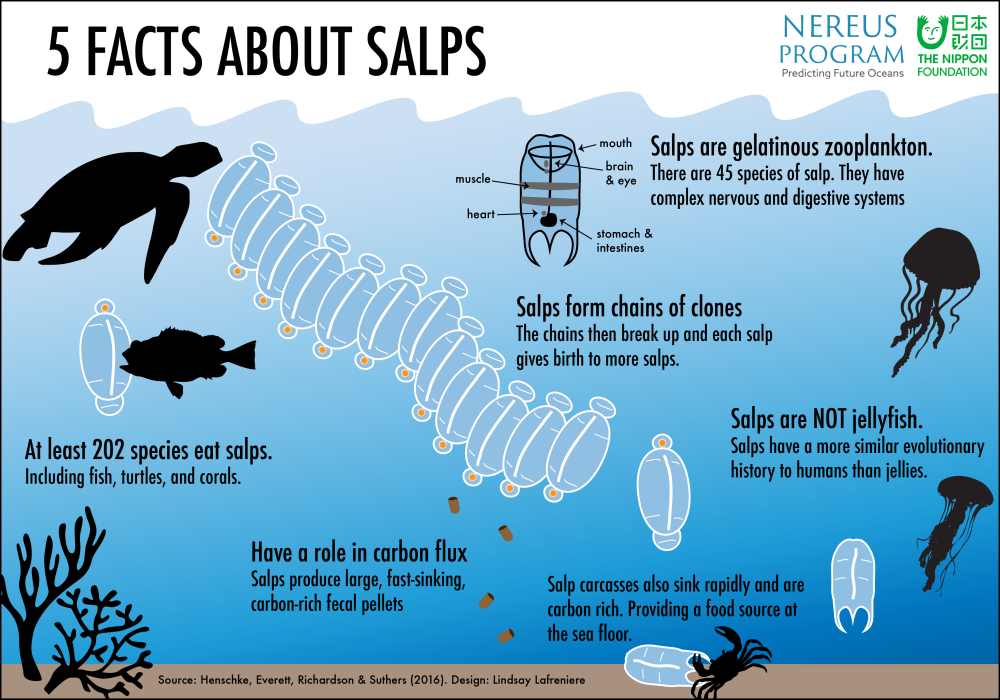Well at least this name is easy to spell and not hard to say, but what on earth is it? That image above looks like a squashed plastic toy fish. Why should I care about it? Salps provide us with important services in terms of carbon pathways and we need them around.
Page Contents
Background
What is a salp?
Salps belong to a group of marine organisms called tunicates, which have soft bodies surrounded by a tough sheath for protection. Salp bodies are barrel-shaped and internally gelatinous. Along with other animals which are free swimming and softbodied, they form part of a group called the gelatinous zooplankton. Jellyfish are a primitive type of gelatinous zooplankton, but they are completely different from salps. The salps are classified as tunicates which means they all have a notochord which is a precursor of a backbone. They have a mouth, heart, brain, stomach, intestines and gonads, but underdeveloped or absent sensory organs. They vary in size from a few millimetres at their birth and grow up to about 15 cm in most species. The largest known species is a bit over 30 cm long. They have a somewhat complex reproductive cycle involving an asexual phase where they live as solitary organisms and a sexual phase in which they live in colonies. These colonies are chains which can be linear, circular or spiral in shape and involve many individuals.
There are about 45 species of salp. Most salps have very fast reproductive rates.
Examples in solitary phase
Examples in colonial phase
Distribution
Salps are found globally. They are generally found in the open ocean, although they may occasionally be washed up on beaches. They live in every ocean around the world except the Arctic, with the highest density found in the Southern Ocean. Two species of salp are common in Antarctic waters, and other species have been found as far north as seas off British Columbia, Canada, and are common off the coast of Washington, USA.
Ecology
Salps are non-selective filter feeders which means they do not filter food organisms by size, hence feed on bacteria as well as larger plankton. They do this by using muscle bands to pump water in one end of their body, and then move it across a mucus covered surface, absorbing the oxygen and capturing organisms. Then, they push what is left of the water, plus their faeces out the other end. This stream of seawater is used for obtaining oxygen and feeding, and is also their method of locomotion .
Salps are an important food item for many fishes including some species of leatherjackets, sunfish, and Angelfish. They may also be eaten by turtles, seabirds, crustaceans and jellyfish.
Salps numbers are difficult to ascertain because they are fragile and easily damaged by nets. Salp numbers can swell and drop dramatically, according to food availability. Salps can grow very fast. During a swarm, salps can cover an area up to 100,000 square km, with densities of more than 5000 individuals per cubic meter.
Video by Alison Perkins
Services
According to the Australian Museum,
Salps have a complex life cycle, growing so fast that they can grow to maturity in 48 hours. They are thought to be the fastest growing multicellular animal on Earth, increasing their body length by up to 10% per hour. This quick turnaround time enables salps to take advantage of algal blooms, increasing their population size rapidly when there is a sudden abundance of food. Because of this, salps are very important for cycling nutrients through the different depth zones of the ocean. As they move up and down through the ocean, eating and excreting, they spread nutrients downwards to other ocean communities.1
Further more, as The Woods Hole Oceanic Institution explains,
The oceans absorb carbon dioxide from the atmosphere, including some of the carbon dioxide emitted by fossil-fuel burning. In sunlit surface waters, tiny marine phytoplankton use it to grow. Animals then consume phytoplankton and incorporate the carbon, but most of it dissolves back into the oceans when the animals defecate or die. The carbon can be used again by plants, or it can return to the air as heat-trapping carbon dioxide.
Salps send carbon down a third path by making heavy, fast-sinking fecal pellets that efficiently ship carbon to the deep sea, where it is sequestered from the atmosphere, thus influencing rises in carbon dioxide levels.2

Cultural influence

Salps could hardly be said to have a strong cultural influence as most people are unaware of their existence, but Azerbaijan celebrated the existence of the salp, Pegea confederata, with a stamp in 1995.
Summary of services provided for us
- Salps maintain the integrity of the food web they occur in.
- Salps play a major role in nutrient recycling and carbon fixing in the ocean.
Threats to the services?
We do not have data on the conservation status of salps, because we do not have population figures. As noted above, salp population numbers can vary tremendously in response to food availability.
What can we do to retain these services?
We do not know enough about them to be aware of threats they may be facing, so we need to do more research into their biology and ecology. Having dismissed their importance for so long, we have a lot of catching up to do.
Dig deeper
- Gelatinous Zooplankton-Mediated Carbon Flows in the Global Oceans: A Data-Driven Modeling Study
- Marine Ecology: Gelatinous Bells May Ring Change in Marine Ecosystems
- Sinking of Gelatinous Zooplankton Biomass Increases Deep Carbon Transfer Efficiency Globally
Salps are closely related to a group of organisms that are truly bizarre in appearance and huge in size. See https://www.youtube.com/watch?v=qis_rfb7fnU for a video of a pyrosome. Jaw dropping!









